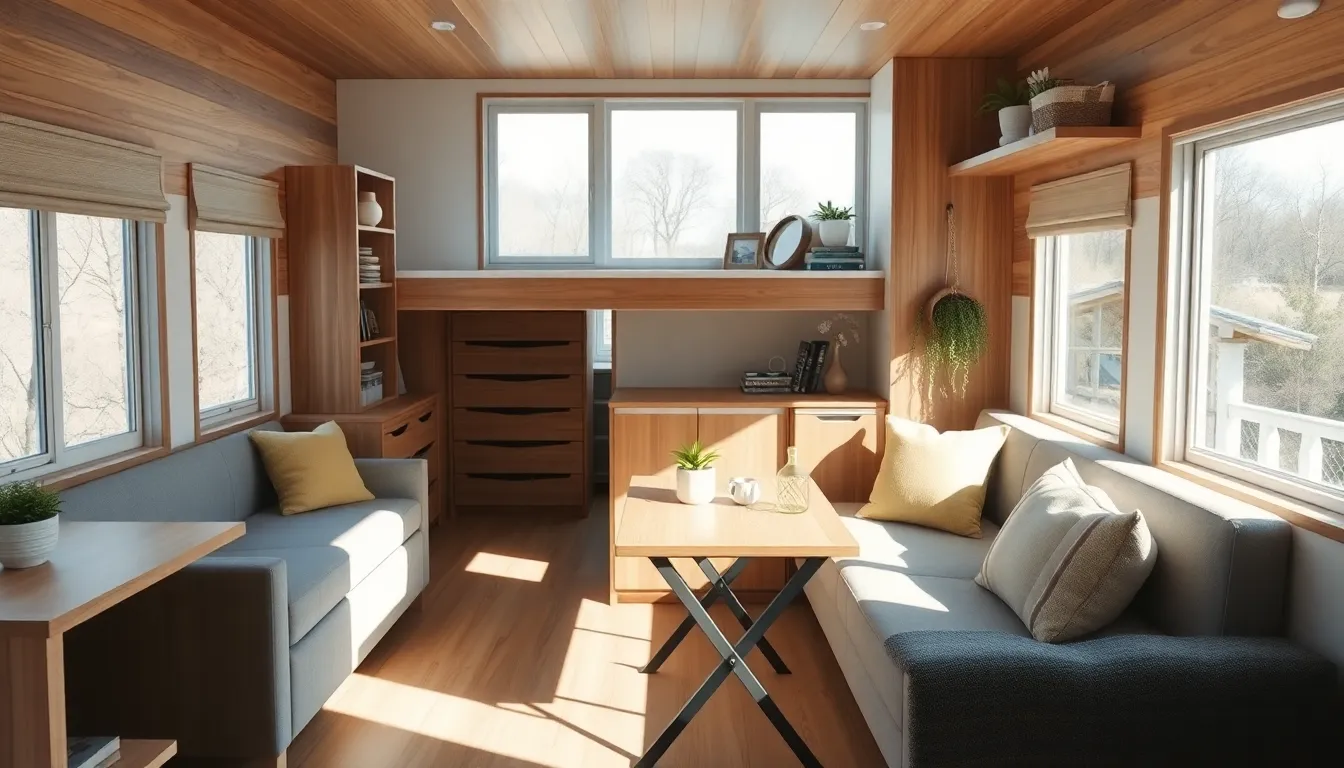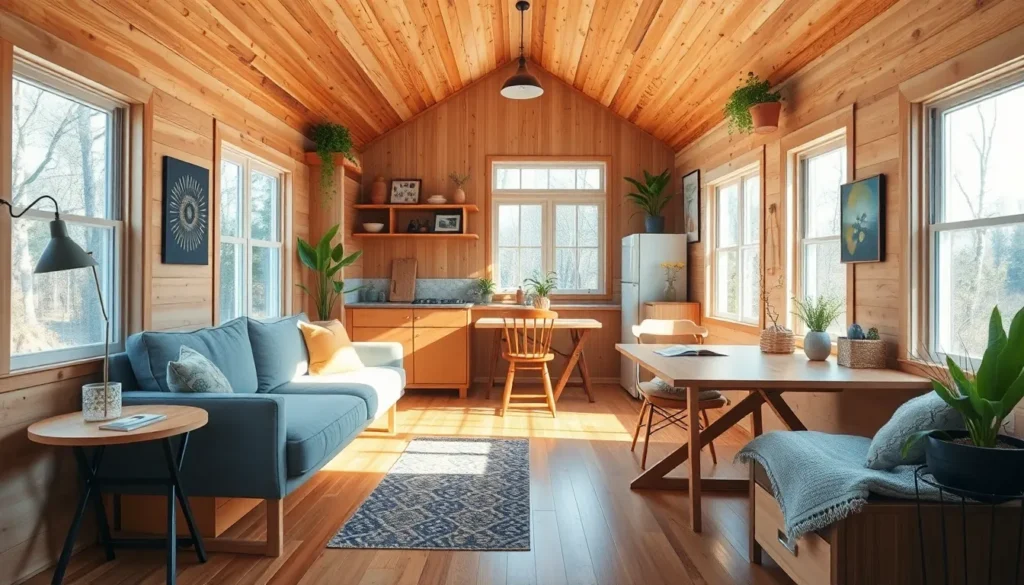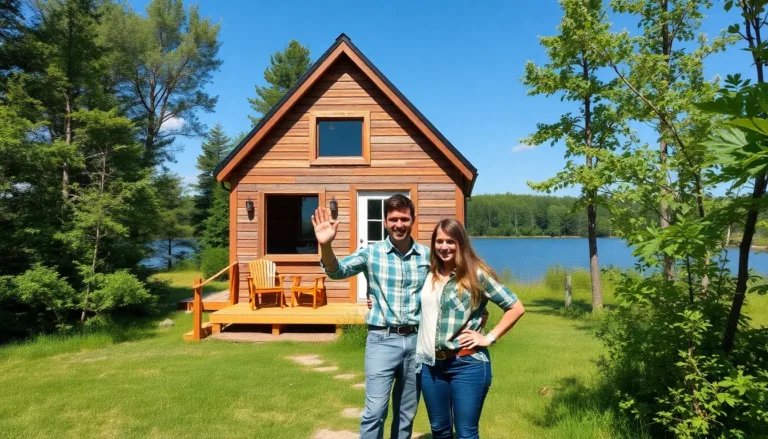Table of Contents
ToggleTiny homes are taking the world by storm, proving that good things really do come in small packages. With their clever designs and cozy vibes, these pint-sized dwellings are a breath of fresh air in a world filled with sprawling mansions and endless square footage. Who needs a 10,000-square-foot home when you can have a stylish sanctuary that fits on wheels?
The Appeal of Tiny Homes Interior
Tiny homes interiors captivate many with their efficient use of space. A well-designed tiny home incorporates multifunctional furniture, maximizing utility without sacrificing style. Its cozy atmosphere often features warm color palettes, inviting textures, and smart layouts that emphasize comfort.
Minimalism plays a key role in tiny home design. By eliminating unnecessary items, residents create environments that feel more open and serene. Storage solutions, such as under-bed drawers and wall-mounted shelves, enhance organization while maintaining aesthetic appeal.
Sustainable materials frequently define tiny home interiors. Bamboo flooring, reclaimed wood, and recycled metals contribute to an eco-friendly ambiance. These choices reflect a growing desire for environmentally conscious living among homeowners.
Natural light transforms small spaces. Large windows and skylights allow sunlight to flood interiors, making them feel larger and more inviting. Proper lighting design ensures warmth during evenings, enhancing the homey feel.
Personalization enhances the charm of tiny homes. Residents often express their individuality through curated decor, handmade furnishings, and unique art pieces. These personal touches create a connection, turning a compact space into a cherished sanctuary.
Community aspects of tiny living attract enthusiasts. Many tiny home communities prioritize shared green spaces and communal areas, fostering connections among residents. This sense of belonging adds to the appeal of tiny home living.
Overall, tiny home interiors deliver a perfect blend of functionality and style. Transforming limited space into inviting areas offers countless possibilities for unique living experiences.
Design Principles for Tiny Homes

Design in tiny homes focuses on maximizing limited space while promoting functionality and comfort. Clever layouts enhance living experiences in these compact dwellings.
Maximizing Space Efficiency
Space efficiency represents a core design principle in tiny homes. Incorporating multifunctional furniture allows residents to utilize areas effectively. Examples include sofa beds and foldable tables that adapt to different situations. Vertical storage solutions, such as shelves and cabinets, help keep belongings organized while maintaining an open feel. Utilizing under-bed storage offers additional room for items without cluttering visible spaces. Strategic use of open floor plans encourages fluid movement throughout the home. Large windows and reflective surfaces create an illusion of more space, contributing to a light and airy atmosphere.
Embracing Minimalism
Minimalism plays a vital role in the design of tiny homes. Prioritizing essential items helps create serene environments free from clutter. Residents embrace simplicity by focusing on quality over quantity, choosing pieces that offer both functionality and aesthetic appeal. Neutral color palettes contribute to a calming atmosphere, while carefully selected decor enhances personal style. Storage solutions integrate seamlessly into the overall design, ensuring that every item has a designated place. This intentional approach allows for easy maintenance and fosters a sense of tranquility. A mindful lifestyle aligns with sustainability goals, reinforcing the commitment to eco-friendly living.
Essential Elements of Tiny Homes Interior
Tiny homes maximize living space with clever design choices. A focus on essential elements ensures these compact areas remain functional and stylish.
Multifunctional Furniture
Multifunctional furniture plays a pivotal role in tiny home interiors. Transforming a dining area into a workspace easily accommodates diverse activities. Sofa beds provide comfortable seating during the day and ample sleeping space at night. Stackable chairs can offer guest seating while being stored away to save space. Foldable tables create an opportunity for dining or work while conserving room. Every piece serves multiple purposes, maximizing utility without compromising aesthetics.
Smart Storage Solutions
Smart storage solutions enhance organization in tiny homes. Utilizing vertical space with wall-mounted shelves creates more floor area while maintaining accessibility. Under-bed storage specifically capitalizes on often-overlooked areas in bedrooms, keeping belongings out of sight. Built-in cabinets can blend seamlessly with the decor, ensuring a cohesive look. Utilizing baskets and bins provides easy access to everyday items and keeps clutter at bay. Every effort to incorporate effective storage contributes to a more serene and inviting atmosphere.
Aesthetic Trends in Tiny Homes Interior
Tiny homes embrace a variety of aesthetic trends that enhance their unique charm and functionality.
Color Schemes and Materials
Bold color schemes and natural materials often define tiny home interiors. Neutral tones like whites and grays create an open feel while accent colors add vibrancy. Earthy hues promote tranquility, aligning with eco-friendly principles. Wood finishes, including reclaimed wood and bamboo, enhance warmth and invite sustainability. Industrial elements, such as metal fixtures, blend modernity with rustic aesthetics. Textile choices should complement the color palette, featuring soft fabrics that evoke comfort without overwhelming the visual space. Each design element plays a role in fostering a cohesive, stylish environment tailored to personal taste.
Incorporating Nature
Integrating natural elements into tiny homes enhances both aesthetics and overall well-being. Large windows and glass doors flood spaces with sunlight, creating an illusion of openness. Consider indoor plants, which improve air quality while adding a touch of greenery. Utilizing natural stones and organic materials helps create a seamless connection between indoor and outdoor spaces. Additionally, nature-inspired decor—think botanical prints and wood accents—can reinforce this theme. Sustainable practices, such as using recycled materials, contribute to an eco-conscious mindset while promoting the beauty found in the environment.
Tiny home interiors stand out as a testament to creativity and efficiency. They prove that limited space doesn’t mean sacrificing style or comfort. With clever designs and multifunctional furniture, these homes maximize every square inch while maintaining a cozy atmosphere.
The integration of natural light and sustainable materials enhances not just aesthetics but also well-being. Personal touches in decor reflect individuality, making each tiny home unique. As more people embrace this minimalist lifestyle, tiny homes will continue to inspire those seeking a harmonious blend of functionality and charm.







